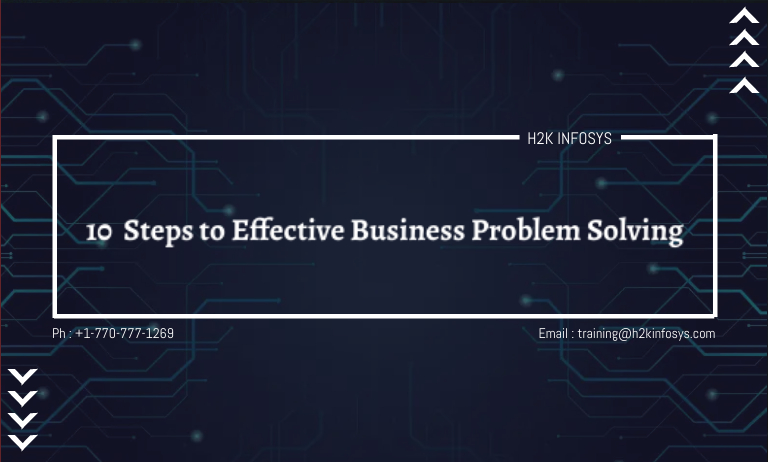10 Steps to Effective Business Problem Solving

In business analysis, the importance of acquiring problem-solving skills for solving business problems cannot be overemphasized. These skills will give you a better understanding of how to identify business problems and also find possible solutions. This explains why several business professionals are enrolling in Business Analysis Certification Training.
In this guide, we will analyze ten steps to effective business problem-solving. They include;
Step I: Define the Problem
The first step to effective business problem solving is to identify and define the problem clearly.
Turning a blind eye to problematic issues affecting a business can make brands or companies go out of business. So, it is important to acknowledge that a problem exists and the problem needs a solution. You have to be clear about what the problem is since there might be different views as to where the problem lies. This will help you address the main issue and not irrelevant ones.
Defining the problems affecting your business will help you discover an opportunity to improve.
Step II: Evaluate the Problem
There’s more to identifying and defining the problem affecting a business. You need to evaluate what the business problem is before coming up with possible solutions.
For instance, most business owners will choose to increase brand awareness whenever there’s a drop in sales of their products. While that is a good strategy based on studies from Business Analysis Course online, it might not be the perfect approach to solving the sales drop issue.
Hence, business owners should evaluate the actual problem. This step involves analyzing the business problem from different angles in order to get a better understanding. The better the evaluation of a business problem, the higher the chances of getting the best solutions.
Step III: Identify the Cause of the Problem
Before the management of a business organization starts executing solutions to a business problem, they first take the time to identify the root cause of the problem. This is a vital approach to effective business problem solving as it will help you identify core symptoms.
According to teachings from Business Analysis Online Training; there’s a tendency for a business problem to resurface if you don’t get to the root cause. In other to identify the root cause of a business problem, you need to consider the following factors;
- Business Goals: ensure your business approach is in alignment with the goals
- Business Model: explore new business models that affect costing and pricing
- Business Team: investigate any issues affecting the productivity of your team
- Business Competitors: learn about the strategies of competitors in your niche
- Market Factors: determine how the market economy is affecting your sales
Considering each of these factors will help you get to the root cause of a business problem.
Step IV: Brainstorm Possible Solutions
Once you identify the cause of a business problem, the next step involves identifying possible solutions. Coming up with multiple solutions when planning to solve a business problem will help business organizations design a perfect solution. The more possible solutions you discover, the higher the chances of identifying the right one. So, you should consider using the “design thinking approach” that involves adopting the input of a wide array of people in the problem-solving process. You can learn more about this through Business Analysis Online Training.
Step V: Conduct S.W.O.T Analysis
This problem-solving strategy is a popular approach used for identifying a business’s strengths and weaknesses. S.W.O.T Analysis is an effective problem-solving strategy because it allows business organizations to identify problems before they affect the business. It is a great way for businesses to become more self-aware. So, it is easier to come up with solutions whenever problems arise.
From Business Analysis Course online, here is a breakdown of this strategic planning tool;
- S – Strengths {Factors that make the business stand out like skills set/quality products}
- W – Weaknesses {Resource limitations and business deficiencies}
- O – Opportunities {Increased brand awareness and emerging demands for products}
- T – Threats {Emerging competitors, changing regulatory and customer attitude}
Step VI: Conduct Market Research
A business problem-solving approach will not be complete without conducting detailed market research. This process involves gathering and analyzing data related to your business. You need to conduct a customer survey to understand their needs and reactions to your products.
With this approach, business organizations can identify their customer’s pain points, buying habits, and marketplace demographics. The information gathered here will give you a better understanding of the market landscape, which will in turn help you solve business challenges.
Step VII: Gather Input from Your Team
As the popular saying goes; no man is an island of knowledge. This is why it is necessary to gather input from your team members. Enrolling in Business Analysis Online Training will help you with this approach. Seeking input from your team or business advisors will expose you to different opinions and ideas on the issues your business is facing.
The feedback received from their expertise and experience in the field can then be gathered to gain more insight on ways to best solve your business challenges. This is an effective problem-solving strategy because the input received can help you form effective long-term solutions.
Step VIII: Make a Decision
At this stage, you have to take a forward step by deciding on the course of action to implement.
You need to first prioritize the potential solution you want to adopt. This involves weighing the pros and cons in order to identify the best option. Once you identify the best solution option to implement, take the necessary actions in order to avoid further losses. Delaying the time to make a decision can increase cost, so ensure you set a deadline for making the decision.
You can use a decision-making framework from Business Analysis Online Training for this step.
Step IX: Measure the Solution Results
Measuring the result of your problem-solving process involves tracking the progress. Doing this will make business owners know when a business problem has been solved or if the process is still in progress. The process of solving a business problem can be complex, so it is necessary to adopt this approach. That said, it is essential to identify key metrics to track. This involves;
- Taking a baseline measurement
- Deciding on the key performance indicators
- Setting a goal and timeframe for the solution
This strategy will help you track your success when solving a business problem.
Step X: Accept the Consequences
Finally, you have to live with the consequences of the problem-solving approach you deployed. Once you implement a solution for a given business problem, you are faced with two outcomes. It’s either the problem gets solved or the issue escalates. It’s a win-win situation if the problem gets solved but can you deal with the consequences that might follow if the problem escalates?
You should learn to deal with whatever outcome, which will make you a good business leader.
You will set your business up for success if you understand the right approach to problem-solving. So, ensure you enroll in a Business Analysis Certification Training program today.
Conclusion
Identifying an effective problem-solving approach is essential in finding a solution for business problems. Applying the wrong approach can lead to a waste of time and resources, which is why we’ve decided to break down the steps to effective business problem-solving.
As an entrepreneur or business owner, you have to learn to be proactive whenever you’re faced with issues or challenges in your business. So, ensure you adopt the steps in this guide.





